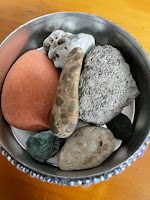 |
| Solovetsky Stone in Moscow CC, Andy House |
 |
| Piece of coal from Ukraine |
There are many best things about books, and here’s another one … they become stepping stones to more books, more ideas, more worlds. Often a bibliography at the back of a book helps lead the way. Other times, the tantalizing crumbs are scattered throughout.
In Memory of Memory by
Maria Stepanova I was eager to follow up on a couple of items—the
Blue Scarf, a popular song during the Soviet times and the
Solovetsky Stone.I’ve always been drawn to stone, as my previous book titles confirm, and my fascination with them goes beyond my writing. I have stones with a variety of histories scattered throughout my home and garden. Their timelessness, their uniqueness, their silence attracts me—they bear witness to history.
 |
| Baltic Amber posing as stones |
So, what was the Solovetsky Stone that Stepanova mentions in her memoir? The huge boulder is a monument dedicated to political repression in the Soviet Union. It’s right in Moscow at Lubyanka Square, close to the secret police headquarters made famous in our western world by the cold war’s KGB, but previously known as the Cheka, the OGPU, the NKVD and now morphed into the FSB. Yes, modern Russia still needs its secret police.
 |
Red Stone from windmill's
foundation in Federofka, Ukraine |
This ordinary-looking stone monument was unveiled in 1990, after the collapse of the Soviet Union. October 30th is marked as the annual day to remember victims of political oppression. How was that day handled last month? I missed hearing about it.
The granite boulder comes from the Solovetsky Islands in the northern White Sea. One of my uncles perished out there. An older brother of my mom’s, he was arrested along with her father. I never created a character out of him for my earlier novels (The Kulak’s Daughter or Red Stone) because he wasn’t in the photos done before and after the 1930 exile and his very existence seemed murky. If there’s no photo, then did he really exist? Now that’s a scary thought.
 |
| Limestone from shores of Lake Winnipeg |
Later, I could indeed confirm his tragic life. Back in 1931, as a fifteen-year-old he’d been considered old enough to help build the White Sea Canal. So he’d just disappeared into that no man’s land of rocks, cold and OGPU tyrants. My way of honouring him has been to use his name for my protagonist’s younger brother. That’s all rather confusing, but the truth is, my mom had three brothers … Albert, August and Jonathan, a toddler. Little Jonathan died en route to Yaya, Siberia. August, (called Albert in my books), ended up fighting for the Wehrmacht and disappeared in a Soviet forced labour camp in 1945 while the real Albert, pushed boulders for Stalin’s White Sea Canal.
 |
Stone stories from my
daughter's Europe trip |
The
Solovetsky Stone in Lubyanka Square is for that un-photographed Albert, for my fictional Albert (aka, August), and for little Jonathan. All three youths were victims of political repression in the Soviet Union. Three uncles, dead through Stalin’s policies, along with my two maternal grandparents, victims as well. Yes, that Solovetsky Stone in Moscow commemorates my family, too.
When my daughter traveled throughout Europe one summer she brought back a collection of her own storied-stones to share with me.
Because stones can't talk—they can only listen—they need us to speak for them. Stepping stones, indeed.
Now I need to follow-up with the Blue Scarf.








No comments:
Post a Comment